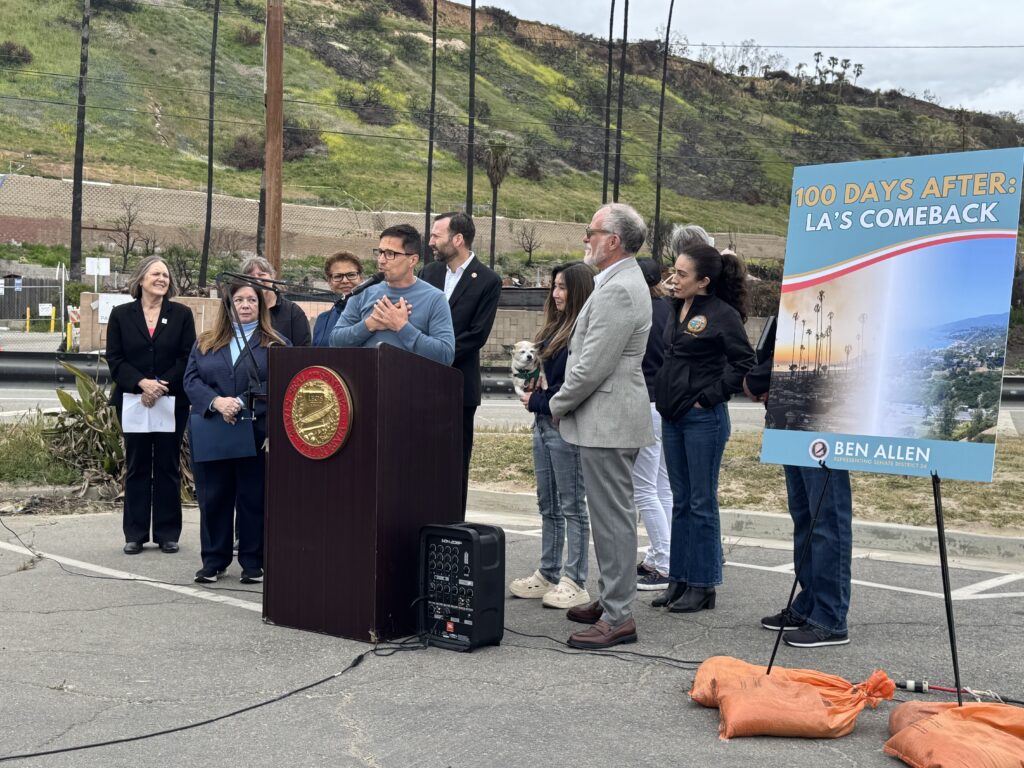
Palisades Bowl resident Jon Brown spoke about the enormity of losing his home at the Palisades Bowl. He is surrounded by residents and city, county and state officials. In the background is Palisades Bowl.
At the two-hour press conference held by State Senator Ben Allen at Will Rogers State Beach across from Palisades Bowl, a diverse assortment of officials gathered to help mark 100 days since the start of the Palisades Fire. All were eager to show how they’ve helped residents.
While the mostly self-congratulatory remarks were being made, the audience and cameras were situated to see the devastation of the Palisades Bowl Mobile Home Park across Pacific Coast Highway. Four hundred people are without a home, another 300 residents in the adjoining Tahitian Terrace, are also homeless.
Allen, who also acted as the emcee, said, “We have lots to celebrate, but we have so much to do.” He said that the state of California had passed $2.5 billion in state relief to support emergency response.
State Senator Sasha Perez, who represents the Eaton area and who was only in her second day of office when the fire happened, said that there are 12 bills currently in the legislature to help victims.
Insurance Commissioner Ricardo Lara said that the top priority was for “people to recover quickly and on their own terms.” He pointed out that his office provided for more than 1,000 survivors through four events. “There have been 38,000 claims filed and 27,000 partially paid. The market is responding as it should,” Lara said.
L.A. Mayor Karen Bass said, “I feel proud of what we’ve been able to do.” She listed accomplishments as setting up the disaster recover center that had helped 9,000 people, the speed at which the Army Corps of Engineers is clearing lots – it took only six days to clear the Palisades Library. “We’re on track to have the fastest recovery of a disaster in U.S. History.”
Councilmember Traci Park had just returned from a trip to Lahaina. She had paid out of her own funds to go and see if there were any lessons that could be learned and applied to Pacific Palisades. “We need to take a moment for the lives that were lost in the fires,” she said, and spoke about the gravity of what was lost. “We demand answers, and I called for an after-action report,” she said.
Pro Tem Malibu Mayor Marianne Riggins said, “The City is looking at long-term options and has waived the fees for like-buildings and is working on micro-grants for businesses. We’ve removed barriers to streamline changes for rebuilding.”
“One hundred days is not enough to feel settled or whole again,” she said.
L.A. County Assessor Jeff Prang spoke about aligning the assessment standards between the County and the City. (Editor’s note: he had several other important updates that will be in a future story.)
Allen spoke about the introduction of Senate Bill 749 that will reduce discrepancy in law between affordable housing vs. mobile homes. If the owner wants to close the park or change the use of the land, i.e. from affordable to market-value housing (even after a disaster), they would first have to give residents or qualified affordable housing nonprofits/entities the opportunity to purchase the land in order to maintain its use as affordable housing, and they will be forced to sell the land if either group can meet market value.
He invited Bowl resident Jon Brown to speak. Brown, who has lived at the Bowl with wife and two children, was accompanied to the podium by three other residents. Brown, a 10-year resident of the Bowl, spoke about the 99-year-old woman who lived in one home and of two other women who swam daily in the pool. “At least a quarter of the residents were senior citizens,” he said “This is one of the last pieces of affordable housing in Pacific Palisades.”
City Attorney Hydee Feldstein Soto said that Senate Bill 522 seeks to extend local rent control regulations on residential properties rebuilt after the Los Angeles County fires. It has not passed yet.
To cap the afternoon, Heidi Sanborn who founded the nonprofit, the National Stewardship Action Council in 2015, spoke about the future and how we need to make everything more fire resilient and stop hazardous products in our homes that burn in wildfires.
This editor had three flashlights in her home. They all had batteries, they all burned – producing hazardous waste. The house had been remodeled in 1994, which meant the asbestos had been removed and the lead paint gone. There was one propane tank under the barbeque it survived – because a wall fell on top of it. The sides of the home were stucco, which is fire resistant.
The roof was asphalt – also considered fire-resistant. There were no attic vents. Brush clearance was done.
Why did the home burn? The house was “hardened.” The term is what all fire victims who are rebuilding are now lectured to do. Fire is a chemical reaction between fuel and oxygen in the air. A fire will occur any time the temperature is high enough.
To put out a fire, one needs water or a retardant, not lectures.
What has the National Stewardship Action done?
According to their website, NSAC offers consulting services to state and local governments, corporations, and other organizations to identify solutions to materials management issues for products. These include tobacco and cannabis waste, carpet, packaging, pharmaceuticals, sharps, solar panels, mattresses, textiles, hazardous waste including paint, critical earth minerals such as batteries and solar panels, and much more click here.
The group has provided expert testimony in California: 1. Assembly bill 622 (Allen) which would eliminate an unnecessary mandate requiring licensed cannabis cultivators to affix a single-use plastic tag to each cannabis plant. 2. Senate bill 676 (Allen) which would allow a city/county to enact or enforce any regulation that prohibits the installation of synthetic grass or artificial turf. 3. Assembly bill 1059 (Friedman) which prohibits juvenile products, mattresses, or upholstered furniture that contains textile fiberglass, and restricts the use of flame-retardant chemicals in adult mattresses.
When a resident has been through the Palisades Fire and their home has burned and all of their possessions and memorabilia are gone, the last thing they need is a lecture about the future and how recycling will prevent hazardous wastes from burning.
This editor pointed to the mounds of trash that was all that was left of the Palisades Bowl and asked Allen, “The next big rain and that goes in the ocean, it seems that would be an immediate concern.”
Immediately Feldstein Soto was brought to the lectern and explained that there were still 63 properties that had neither opted in nor opted out. She was asked if that was one of them. She didn’t know.
One of the many questions that was not answered was “How did this fire get out of control and why wasn’t there water to stop it and why wasn’t the electricity turned off to prevent additional arching/sparking?”
And most importantly, “How can you ensure this will never happen again?”
(Editor’s note: Some think that marine animals, such as this sick sea lion, are having issues because of the hazardous waste coming from fire debris.
)

Am I the only one who just wants to throw up after reading about politicians congratulating themselves? And I can’t stand looking at that dim pseudo-mayor bASS. She’s as dim as a light bulb in a chicken coop. 🤮
Our government officials should be required to report routinely on the following topics BEFORE they discuss any other issues. At every meeting every last one of them needs to reassure us, before any other words are spoken:
1. Provide an apology for the next 100 YEARS for their failure to protect us and their abject incompetence
2. Assure us hillside brush clearance is immaculate
3. That fire engines actually work
4. That the fire department is fully staffed and ready to pre-deploy in force before known wind events
5. That local reservoirs are filled and at capacity and that hydrants actually work
6. That hillsides are patrolled to remove illegal encampments on a daily basis and most definitely before a wind event
6. That criminals with fireworks and explosives are removed from this town
Yeah, after that I’ll listen to anything else they want to say.
The biggest disaster this town encountered was this government.
well said Mary